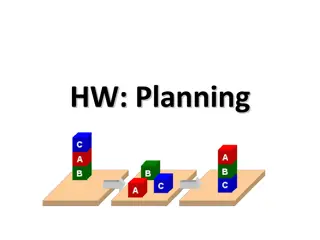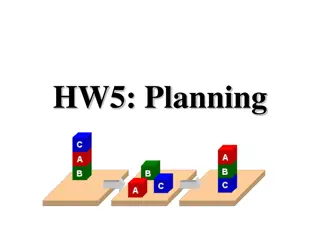
PDDL Planning Domain Description Language
"PDDL, based on STRIPS with various extensions, is a classic specification used in the International Planning Competition series. Widely utilized for over two decades, PDDL continues to be a standard input and output format, supporting multiple agents and ontologies with its Lisp syntax."
Download Presentation

Please find below an Image/Link to download the presentation.
The content on the website is provided AS IS for your information and personal use only. It may not be sold, licensed, or shared on other websites without obtaining consent from the author. If you encounter any issues during the download, it is possible that the publisher has removed the file from their server.
You are allowed to download the files provided on this website for personal or commercial use, subject to the condition that they are used lawfully. All files are the property of their respective owners.
The content on the website is provided AS IS for your information and personal use only. It may not be sold, licensed, or shared on other websites without obtaining consent from the author.
E N D
Presentation Transcript
PDDL Planning Domain Description Language
PDDL Planning Domain Description Language Based on STRIPS with various extensions First defined by Drew McDermott (Yale) et al. Classic spec: PDDL 1.2; good reference guide Used in biennial International Planning Competition (IPC) series (1998-2022) Many planners use it as a standard input Latest version is 3.1 and newer variants exist
PDDL is still widely used After 22+ years, PDDL is still used in many planning systems and domains as a standard for input and output It s representation was updated, e.g. adding fluents (facts that change over time) preferences (aka soft constraints) New variants support multiple agents, ontologies, and more It still retains is traditional Lisp syntax
PDDL Representation Task specified via two files: domain file and problem file Both use a logic-oriented notation with Lisp syntax Domain file defines a domain via requirements, predicates, constants, and actions Used for many different problem files Problem file: defines problem by describing its domain, specific objects, initial state and goal state Planner: domain + problem a plan
Blocks Word Domain File (define (domain BW) (:requirements :strips) (:constants red green blue yellow small large) (:predicates (on ?x ?y) (on-table ?x) (color ?x ?y) (clear ?x)) (:action pick-up :parameters (?obj1) :precondition (and (clear ?obj1) (on-table ?obj1) (arm-empty)) :effect (and (not (on-table ?obj1)) (not (clear ?obj1)) (not (arm-empty)) (holding ?obj1))) more actions ...)
Blocks Word Problem File (define (problem 00) (:domain BW) (:objects A B C) (:init (arm-empty) (ontable A) C A (on B A) B B (on C B) A C (clear C)) (:goal (and (on A B) (on B C) (ontable C)))
Blocks Word Problem File (define (problem 00) C A (:domain BW) B B (:objects A B C) A C (:init (arm-empty) (on B A) Begin plan 1 (unstack c b) 2 (put-down c) 3 (unstack b a) 4 (stack b c) 5 (pick-up a) 6 (stack a b) End plan (on C B) (clear C)) (:goal (and (on A B) (on B C))))
Planning.domains Open source environment for providing planning services using PDDL (GitHub) Default planner is ff (aka, fastForward) very successful forward-chaining heuristic search planner producing sequential plans Can be configured to work with other planners Use interactively or call via web-based API We ve used it for to extend blocks world domain in homework





